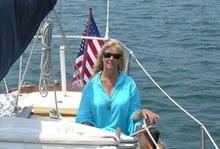
ASNoise220
“I have no set plan. I’m just going to go whichever way the wind blows,” said Barbara Kranichfeld, as she sat aboard Venture, her newly purchased 1969 Pearson Vanguard 32.5, which she picked up in Newport, Rhode Island, last week. Yet all destination indecision aside, Kranichfeld bought her new boat with a very clear purpose. She wants to spread the word about a lesser-known cause of ocean pollution-noise-specifically, the type that humans generate.
Kranichfeld’s not alone. She’s just one North American representative for the International Ocean Noise Coalition, a partnership of more than 150 global organizations, which aims to combat ocean noise worldwide. Kranichfeld and the IONC recently finished a week of meetings at the United Nations in New York, where they addressed officials from 120 countries on the growing problem of underwater racket.
How bad is it? According to IONC, ocean noise has grown at an alarming rate, and in some areas has doubled every decade for the past 60 years. The sources of underwater noise include sonar, commercial freighters, cruise ships, use of explosives, underwater construction, offshore oil drilling, and seismic testing for oil and other related activities.
Kranichfeld points out that all marine species are affected by noise, from the tiniest organism to the largest of whales. Marine animals use sound to navigate, find food, locate mates, avoid predators, and communicate with each other. Flooding their world with intense sound interferes with these activities with serious consequences, such as depleted fish stocks, which according to the IONC, show no signs of replenishing.
According to the IONC, several beachings of cetaceans, including some on endangered species lists, have been directly linked to naval sonar systems. Kranichfeld lists the harsh reality of other detrimental effects on fish, in no uncertain terms. “These animals suffer,” she says. “They experience brain hemorrhaging, imploding lungs, and bleeding from the ears and eyes.”
Living on Venture, said Kranichfeld, is the best way to get the word out about underwater noise pollution. “I can go cruising and talk to the people out there. I can reach more people who really care about this issue.”
Kranichfeld is so serious about the cause that she plans to use the outboard diesel on Venture only when absolutely necessary, and she has friends researching an electric engine for her. Her dinghy has no motor at all.
Kranichfeld is an accomplished sailor who previously has split her time between Hawai’i and Nantucket, and she’s been sailing and racing ever since her father taught her to sail as a young girl. She’s had a variety of careers including selling real estate, and she once co-owned a yacht charter business in Newport.
Kranichfeld plans to start her initial cruises on Venture with friends, not so much for the extra help but for the company. Though her future journeys will be determined by winds and tides, Kranichfeld’s initial cruise will likely be from Newport to Martha’s Vineyard, then on to Nantucket, back to Newport, and then maybe Maine. She hopes to hop on to the Intracoastal Waterway this fall and spend some time in Florida with her brother, and maybe spend the winter in the Bahamas or Cuba. All along the way, she’ll be educating people about what they can do to help stop ocean noise.
“This will be ongoing,” Kranichfeld said. “There’s no time frame.”
For more on the International Ocean Noise Coalition, visit www.oceannoisecoalition.com or contact the skipper of Venture directly to find out how to help or to keep track of her cruising progress at barbkran@yahoo.com








